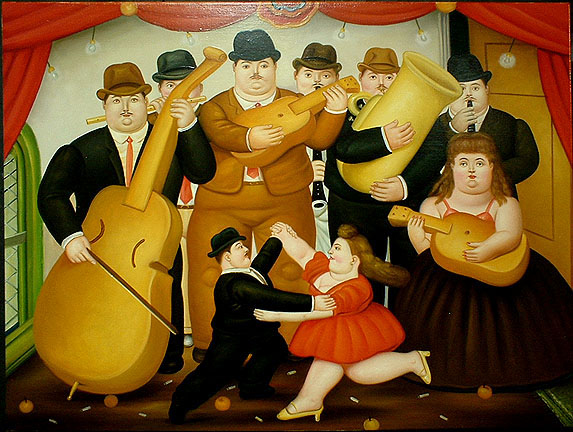BOTERO VS. OBESITY

Fernando Botero, sculptor and painter, challenged the norm with paintings that depicted morbidly obese individuals.-.According to Botero, “an artist is attracted to certain kinds of form without knowing why. You adopt a position intuitively; only later do you attempt to rationalize or even justify it.
Botero’s paintings are more often than not social commentary with political overtones. Born in Medellin, Colombia, Botero moved to Bogota in 1951 and had his first international show at the Leo Matiz Gal. Leaving for Madrid in 1952, he studied at the San Fernando Academy and, from 1953 until 1955, studied fresco technique and art history in Florence, which has influenced his painting ever since. Returning to Colombia, he exhibited at the Biblioteca Nacional in Bogota and began teaching at the School of Fine Arts of the National University. The same year, he spent time in Mexico studying the political murals of Rivera and Orozco, whom’s influence is evident in his political perspective. Botero’s visit to the United States in the late 1950s resulted in he living and working in New York for the next 10 years. Although abstract expressionism interested him, he sought his primary inspiration from the Italian Renaissance. During this period Botero began to experiment with creating volume in his paintings by expanding the figures and compressing the space around them, a quality which he continues to explore in painting imaginary group portraits as well as parodies of works by other famous artists.Widely exhibited in Europe and North and South America, Botero has received numerous awards including the First Intercol at the Museum of Modern Art in Bogota, and is included in major museums worldwide. Since the early 1970s, Botero has divided his time between Paris, Madrid and Medellin.Botero has a broadly appealing style that, unlike much of modern art, needs no explanation. Like it or not, Botero’s art is out there and open to interpretation.Botero has been an international artist star for five decades. He has achieved that by depicting everything as if made of water balloons on the brink of bursting—much of it baroque, if you will.Botero’s inspiration came while he was examining the bulbous body of a mandolin. He was a young artist at the time, enamored with Spanish masters Francisco Goya and Diego Valazquez—artists who occasionally blended the beautiful with the grotesque. Fat in the Arts: Throughout the Middle Ages andRenaissance, obesity was often seen as a sign of wealth and was therefore relatively common among the elite, including the Tuscan General Alessandro del Borro and Charles Mellin, 1645. During the Renaissance some of the upper class began flaunting their large size, as can be seen in portraits of HenryVIII and Alessandro del Borro. The painter Rubens (1577–1640) regularly depicted full-bodied women in his pictures, coining the term Rubenesque. These women, however, still maintained the “hourglass” shape with relationship to fertility. During the 19th century, views on obesity changed in the Western world. After centuries of obesity being synonymous with wealth and social status, slimness began to be seen as the desirable standard.
http://www.latinconnoisseur.com/JUDY_ SAHAGIAN.html
